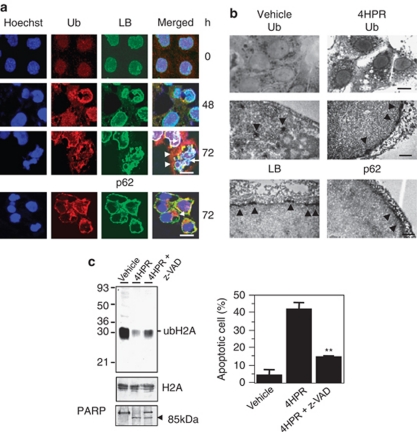Figure 8.
Ubiquitylation of the nuclear envelope and the lamina during apoptosis. (a) Hep3B cells treated with 10 μM 4HPR for the indicated times were fixed and processed for indirect immunofluorescence with antibodies against Ub (red), LB (green) or p62 (green). The nuclei were stained with Hoechst 33258 (blue). The white arrows indicate the lamina in close contact with chromatin. The white arrowheads indicate the aggregated staining of the ubiquitylated proteins in the perinuclear region; scale bar, 5 μm. (b) Optical (upper panels) and electron (middle and lower panels) micrographs of the Hep3B cells. Dark Ub-immunoreactivity can be seen in the cytoplasmic granules of the Hep3B cells treated with the vehicle (upper left). Dark linear Ub-immunopositivity can be seen along the nuclear membrane of the Hep3B cells treated with 10 μM 4HPR (upper right); scale bar, 10 μm. Ub-immunoreactivity (arrowheads) can be seen as electron-dense patches in the nucleus of the Hep3B cells treated with the vehicle (middle left). Electron dense linear Ub-immunoreactivity can be seen along the nuclear membrane in Hep3B cells treated with 10 μM 4HPR (middle right). LB-(lower left) or p62–immunoreactivity (lower right) can be seen along the nuclear membrane in Hep3B cells treated with 10 μM 4HPR. The electron-dense immunoreactive product (arrowheads) is localized at the nuclear membrane of the cells; scale bar, 1 μm. (c) Caspase-dependent inhibition of histone ubiquitylation. Hep3B cells were treated with 10 μM 4HPR in the presence or absence of z-VAD-FMK for 72 h and then lysed. Equal amounts of the acid-soluble proteins of each fraction were resolved electrophoretically on 15% SDS-PAGE gels and the ubiquitylated proteins or H2A as an internal control were detected by immunoblotting. Concurrently, the soluble lysate (cytoplasmic) fractions were immunoblotted for PARP (left). The apoptotic fractions were quantified using a FACScan system (right). Each bar represents the mean of triplicate experiments±S.E.M. (**P<0.01 compared with 4HPR treatment alone)

